Anchovies on pizza are one of those toppings that instantly split opinions and spark lively arguments among pizza lovers. To fans, they’re an essential addition, delivering a rich, salty umami punch that takes a slice to the next level. To critics, however, anchovies are an immediate deal-breaker, often met with skepticism or outright rejection. In this article, we’ll explore the story of anchovies on pizza, from their origins and distinctive taste to the enduring debate over whether they deserve a place on one of the world’s favorite foods.
A Brief History of Anchovies on Pizza
Anchovies have been a traditional topping on pizzas since the early days of this iconic dish. Originating in Naples, Italy, where pizza was first created, anchovies were one of the original toppings used alongside simple ingredients like tomatoes, mozzarella cheese, and basil. As pizza spread throughout Italy and eventually around the world, anchovies remained a popular choice for those seeking a bold and briny flavor on their pies.
The Flavor Profile of Anchovies
Anchovies are small, oily fish that pack a powerful punch of flavor. While some may find their taste overly intense or salty, others appreciate the depth and complexity that anchovies bring to a dish. When cooked, anchovies melt into the pizza, infusing each bite with a rich, savory umami flavor that complements other ingredients such as cheese, tomatoes, and olives.
The Debate Rages On
Despite their historical significance and distinctive flavor, anchovies on pizza continue to divide opinion among pizza lovers. Those who enjoy anchovies praise their unique taste and assert that they are an essential component of a classic pizza experience. They argue that an-chovies add depth and character to the pizza, creating a harmonious balance of flavors that tantalize the taste buds.
On the other hand, detractors of anchovies on pizza often cite their strong, fishy taste and assert that they overpower the other ingredients, making the pizza unpalatable for those who do not enjoy seafood. Some may also find the texture of anchovies off-putting, as they can be slightly chewy or gritty when cooked.
Embracing Diversity in Pizza Toppings
Ultimately, the beauty of pizza lies in its versatility and adaptability to personal taste preferences. While an-chovies may not be to everyone’s liking, their presence on pizza serves as a reminder of the diverse array of toppings available to suit every palate. Whether you prefer classic combinations like pepperoni and mushrooms or more adventurous options like pineapple and jalapeños, there’s a pizza topping out there for everyone to enjoy.
Conclusion
Anchovies on pizza may be a divisive topic, but they undeniably hold a special place in the hearts of pizza aficionados worldwide. Whether you’re a staunch supporter of an-chovies or firmly in the “no an-chovies, please” camp, the debate surrounding this controversial topping adds an extra layer of flavor and excitement to the pizza-eating experience. So the next time you order a pizza, consider giving an-chovies a chance—you might just discover a new favorite topping that surprises and delights your taste buds.










